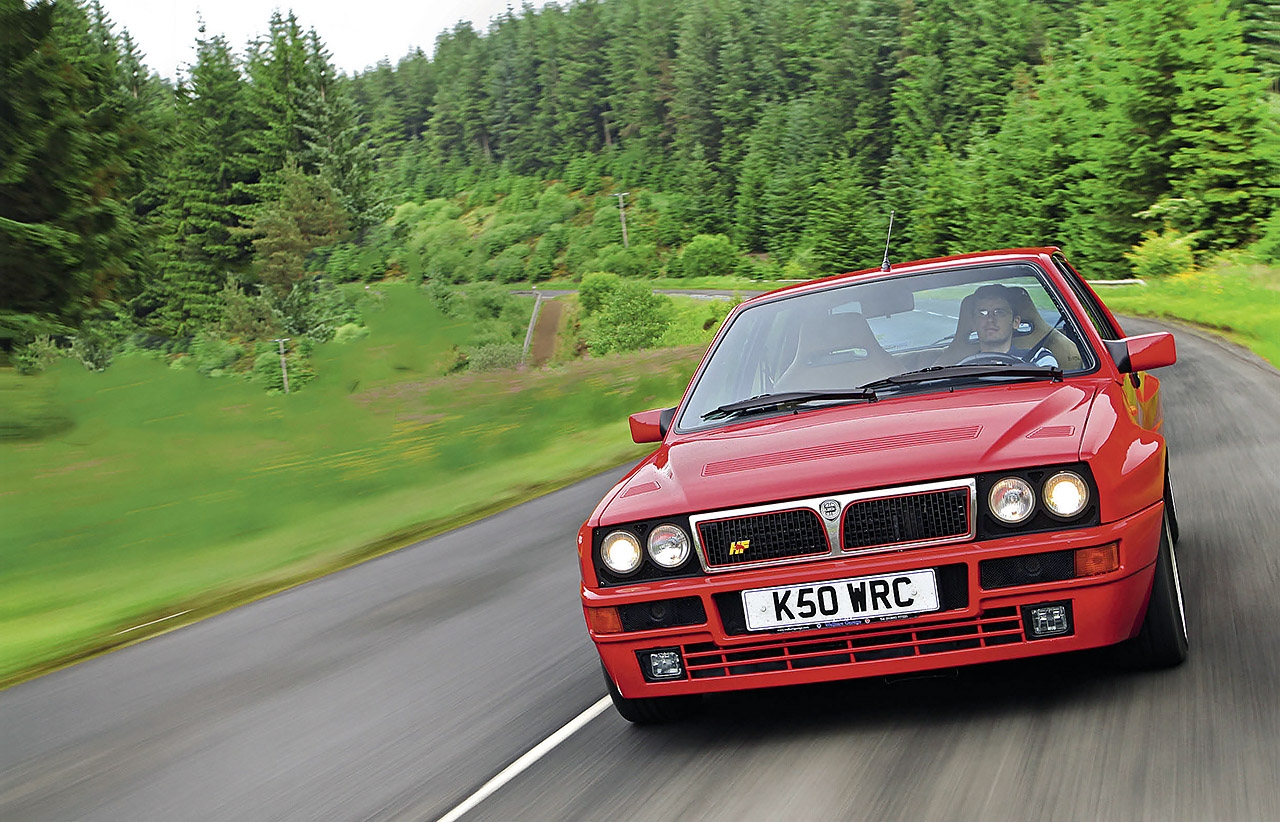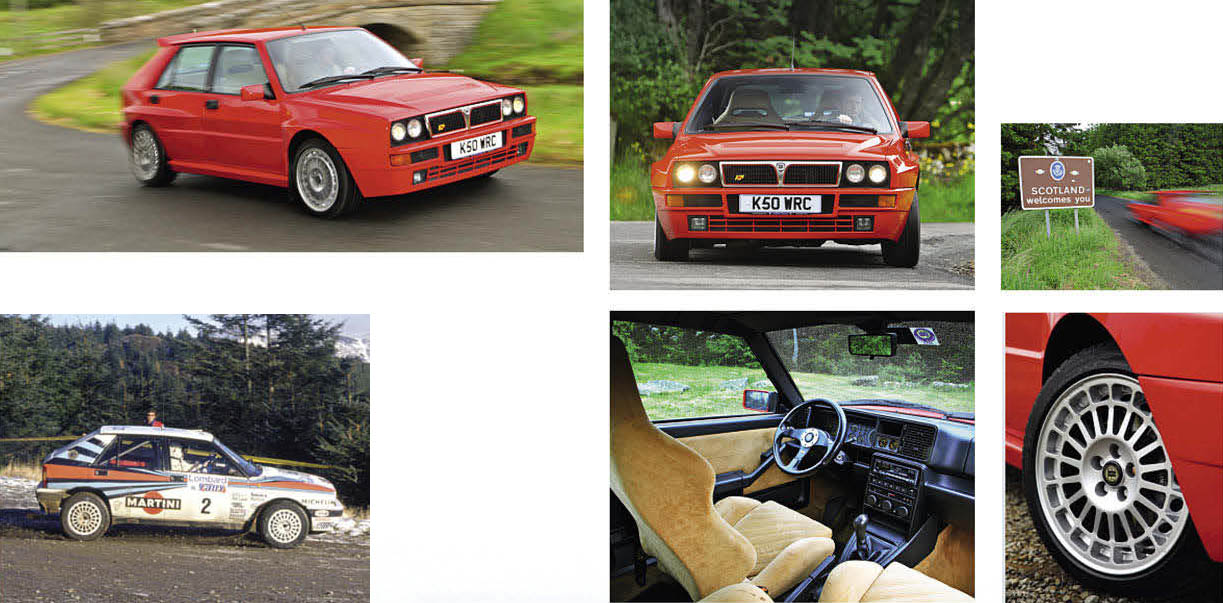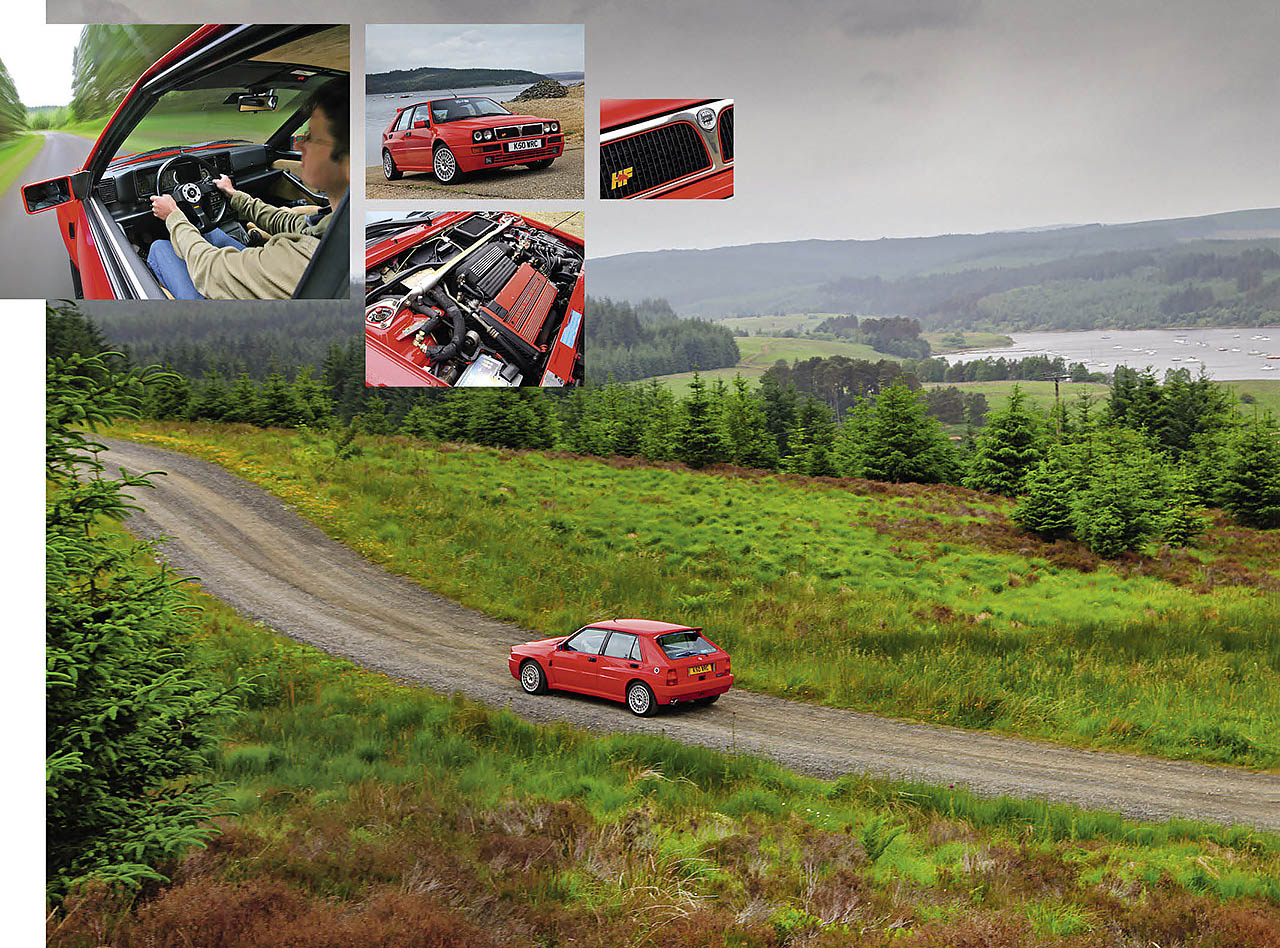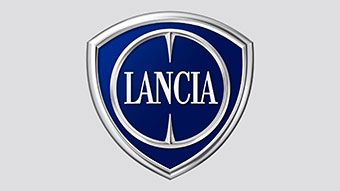
On the trail of the WRC’s glory days. Discovering why few could beat Lancia’s rally icon in the forests. Integrale in Kielder On the trail of Alénina Lancia Delta. The challenge of Kielder Forest is legendary in World Rally Championship lore. James Page heads north in a Lancia Delta Integrale Evo 2 to find out why. Photography Julian Mackie.
The crews were aware of it even before they arrived. It lurked in the back of their minds as they made their way through Wales and the Lake District, heading north. They knew of its reputation, of how it could make or break their event, and none more so than Lancia driver Markku Alén. The Finn had often led as the RAC Rally reached Northumberland, only to fall at this fearsome hurdle. In 1988, his Integrale held a five-minute advantage over the chasing pack but, studying his map in Carlisle, he had reason to pause as he considered the next leg. “Ooh-la-la,” he said quietly. “Kielder…”
This vast complex formed the backbone of a rally that was very different to today’s version. In 2012, 32 cars competed in the Rally GB, held entirely around Wales. The field that Alén led 25 years ago was 178 strong when it left Harrogate, and travelled through the Midlands to Wales, before swinging back up to the Scottish Borders and down into Yorkshire. Swarms of spectators braved wintry conditions to watch at Penmachno, Clocaenog, Grizedale or Dalby, while those at home tuned in to the BBC’s Rally Report, waited for Propaganda’s Duel – surely the finest TV sports show theme – to fade away and William Woollard to round up the day’s action.

The combination of Integrale and Kielder is enough to quicken the pulse of anyone who followed the sport through that era, and there are few places so well suited to Lancia’s pocket rocket. The Italian firm, of course, already had a proud sporting heritage by the mid-’80s. The Stratos claimed a World Rally Championship hat-trick in the previous decade and, in 1983, the 037 was the last rear-drive car to take the title.
By that time, the Group B arms race had started to gather momentum, and Lancia began development of the fearsome Delta S4. This mid-engined, four-wheel-drive, 560bhp machine made its debut on the 1985 RAC, but the deaths of Henri Toivonen and Sergio Cresta in a works S4 on the following year’s Tour de Corse spelled the end of Group B. Such was the sudden nature of the rule change – which came into effect for 1987 and dictated cars that were much more closely related to production models – that many manufacturers were caught on the hop. Peugeot with drew, while Audi struggled to adapt its 200 saloon and Ford its Sierra.
Lancia, however, had just introduced the HF 4WD version of the Delta, and that would do very nicely indeed. The original Giugiaro-designed hatchback had been launched in 1979, and was never intended to be a competition car, but Abarth was given seven months to homologate this latest incarnation. Strictly speaking, 5000 examples should have been built before the end of 1986 but, because of the tight deadlines involved, the sport’s governing body decided that the 3800 or so that had been completed before Christmas was close enough.
In January 1987, the Group A HF 4WD won first time out on the Rallye Monte-Carlo, but work on the uprated Integrale version started straight afterwards. The eight-valve road car was launched at Frankfurt in September 1987 and homologated on 1 March ’1988. There were improvements to cooling – which was always marginal in the cramped engine bay – and flared arches to allow the fitment of bigger wheels. Alarger turbo and intercooler meant that power was up to 185bhp (from 165bhp), while there were larger front discs, plus more substantial springs, dampers and struts.
The need for constant development to keep the rally version competitive led, in May 1989, to a 200bhp 16-valve Integrale, while the final throw of the dice arrived at much the same time that the Lancia works team with drew from rallying. The first Evolution model was shown in September 1991; by the end of the year, the Italian firm had made its announcement. Nicknamed the ‘Deltona’ (big Delta), the 210bhp Evo’s most obvious feature was its wildly flared wheelarches, catering for a track that was 2in wider than before to allow more wheel travel.
There was a new bonnet plus, among other things, revised bumpers, more powerful brakes and uprated suspension. It was a major step that had one final piece of fine-tuning when the 215bhp Evo 2 appeared two years later, and it’s this model that we are using for our pilgrimage.
From an early start in Newcastle, we head north towards Border country, initially sticking to main roads that are all but deserted. When you leave the A696 things get interesting. As you head over the River Rede, the route starts to climb until you cross the A68. Still it rises, not a steady ascent but a series of dips and crests to keep you on your toes. The views across open fields are spectacular, particularly when we reach Hareshaw Head at 330m above sea level; spreading out beneath us lies Kielder Forest.

This immense, brooding presence is no ancient landscape. It was moorland until the 1920s, when a planting programme was initiated that made it the largest man-made forest in Europe. That said, it’s been around long enough to become a legend in rallying. We start to drop, slowly at first, criss-crossing streams and ditches, stone walls on either side, towards Greenhaugh and Lanehead. We cross the North Tyne and join the C200 to follow the river up to Kielder Water and the heart of the forest.
The road from Hott to Yarrowmoor is flatter, with blind kinks and short, sharp bends. The Integrale revels in it, sprinting between corners with minimal fuss. The steering is so lightly assisted that only at parking speeds are you really aware that it is powered, and it’s full of feedback. The wheel is a chunky Momo Corse item that feels perfect – tiny inputs are enough to keenly pitch that wide nose into corners and, in the blink of an eye, you are out the other side and still carrying a huge amount of speed.
The Alcantara-trimmed Recaro seats are wonderful, offering plenty of support during spirited cornering, but the rest of the dashboard is plastic, square and unremarkable except for the astonishing array of dials and lights. The speedo is on the far left, reading in kph and running clockwise from the 9 o’clock position. The rev counter also moves clockwise, but this time from 3 o’clock, and has a 6000rpm redline, while between the two are gauges for battery condition, fuel level, coolant temperature and boost. Further across are yet more instruments for oil pressure and temperature. ‘Cluttered’ would be a charitable description.
To our left, the forest is already starting to close in. Down there somewhere, in the huge site’s south-east corner, lies the Pundershaw stage that played such a pivotal role in RAC Rallies past. On that 1988 event, a nervous Alén led by 5 mins as the field entered a snowbound Kielder, but he lost third gear on the first test at Broomylinn. The Lancia mechanics somehow found their way through the traffic jams and stranded cars into the forest – the main road that we’re on was, according to Autosport’s Keith Oswin, ‘reduced to a twin line of tracks’ – and changed the gearbox in less than half an hour.
Alén had already lost a minute in Broomylinn, then two more over the Whitehill stage on the other side of Kielder Water. By the time he left Pundershaw he’d surrendered the (joint) lead to Hannu Mikkola and Juha Kankkunen. That year, however, Kielder would not have the final word. Alén fought back to the front through the Scottish stages before a spin then a broken driveshaft cost yet more time. He was in the middle of a “maximum attack” chase of the leading pair when Kankkunen crashed early on the final day and Mikkola, blinded by the low morning sun, promptly did the same. Markku was home and dry, and the Integrale continued what the HF 4WD had started by winning the RAC.
Three years later, Pundershaw got its revenge. Alén was by then a Subaru driver, and the stage claimed both him and his teammate, a young Colin McRae, who rolled his Legacy into retirement. Co-driver Derek Ringer radioed Alén, who had fallen victim to a turbo fire, to say that he now understood why Alén hated Kielder. “Yes, yes,” the Finn replied. “Big shit!”
As we continue through a more open stretch, the huge expanse of KielderWater is a constant companion, its eastern edge marked by a dam and, rising from the reservoir, a sinister-looking tower worthy of a Bond villain. The airy feel doesn’t last long, and the trees again encroach as we press on towards Kielder Castle. The road is fast and flowing and, with little in the way of traffic, we can make good progress. Although first impressions of an Integrale can be disappointing – it’s very firm and tends to crash about a bit at slow speeds – it really comes alive when you get stuck into a route such as this. Pottering about is emphatically not what it was designed for.
The engine doesn’t have the spine-tingling sound of a Stratos’ V6, but certainly doesn’t lack power. It idles with a menacing offbeat burble, but from 3000rpm it is smoothness itself, the turbo kicking in for a relentless shove in the back up to 6000rpm. In this Evo 2, it feels more like an engine that’s coming on-cam than on-boost.
Earlier versions have more lag then a bigger step when the turbo spools up. Keep it on the boil and it covers ground at an incredible rate, all the time feeling solidly planted. Coming into Kielder village, there’s an ess-bend that is tighter than it first appears. We carry a bit too much speed through the first section, but the Lancia changes direction swiftly and securely halfway through, dispatching the left-right with ease. Further along, there’s a downhill approach to a tight right over a humpback bridge, the road then climbing away through a steep left. Despite the poor surface, the Integrale shows great composure, enabling us to get on to the power early and slingshot away. It’s ridiculously capable, and there is always the sense that its limits are far, far higher than mine – especially on a public road.
The Delta’s last hurrah on the RAC came in 1991, when this part of Northumberland was again decisive. The event was a championship showdown between Lancia’s Kankkunen and Toyota’s Carlos Sainz. Kielder provided 30% of the overall stage mileage that year and, as the field arrived, Kankkunen’s teammate Didier Auriol led by 29 secs from Sainz, who was 21 secs ahead of Juha. When they emerged, Kankkunen was 3 mins 1 sec ahead of Kenneth Erikkson, who led Sainz’s overheating Toyota by 2 mins 21 secs. Auriol had crashed and was back in 13th, while 30 other cars were stranded in the forest. “Kielder changed everything,” said a victorious Kankkunen. “If you come out of there with no problems, you’ll have a good result.”
In a service area towards the end of the rally, Ford’s Peter Ashcroft assessed the Lancia team: “There’s almost an arrogance about them. They seem to be able to put in a fast time whenever they want. But perhaps things are changing.”
They were. The Evolution models kept the little hatch competitive even after Lancia had with drawn at the end of 1991. The factory supported a Martini-backed Jolly Club team in ’1992, when the Integrale claimed its fifth straight WRC title – six for the Delta including the HF 4WD in 1987. In that time, Kankkunen and Miki Biasion also won four driver’s championships for the Italian equipe before it was finally eclipsed, first by Toyota, then Subaru and Mitsubishi. But what a run, and what a car! The last couple of miles to the border are more open. We charge into Scotland and reflect on the words that opened the Autosport report of that 1991 event: ‘Kielder is the toughest patch of rallying country in the world… In the dark of a wet November night, [it] unleashes a fury unknown anywhere else, a fury which has spelt the end of many dreams and desires.’ But not ours.
Thanks to Andy McFarlane; Lancia Motor Club (www.lanciamotorclub.co.uk)
‘THERE’S ALWAYS THE SENSE THAT THIS CAR’S LIMITS ARE FAR, FAR HIGHER THAN MINE’

Above: powering away after crossing the North Tyne. Right: Alcantara-clad Recaro seats are superb, the plasticky dashboard less so. Left: stiff springing and four-wheel drive mean barely any roll and epic grip. Below: following the RAC north of the border. From top: grippy 205/45s wrap 16in OZ alloys; Alén and Ilkka Kivimäki head for victory on the 1988 RAC Rally; muscular Delta devours undulating roads.
‘TINY INPUTS PITCH THE WIDE NOSE IN TO BENDS, STILL CARRYING A HUGE AMOUNT OF SPEED’
‘THE COMBINATION OF INTEGRALE AND KIELDER WILL QUICKEN THE PULSE OF ANY ONE WHO FOLLOWED THE SPORT THROUGH THE 1980s’

Above: steering is as good a powered system as you are ever likely to discover. Right: twin-cam, 16-valve turbo ‘four’ stretched to 215bhp for final Evo 2. Left: even at rest beside Kielder Water the Integrale has aggressive presence. Below: HF (‘High Fidelity’) badge first seen in the ’60s.






